FOR MORE than a half century now, the name Buick has been important to consumers seeking quality. Built on a rugged foundation of durability and reliability, Buick cars have been a bulwark to the industry over the years, featuring consistently high engineering standards and enjoying wide acceptance from the motoring public.
Those two qualities - reliability and durability - have been foremost in Buick production from the very beginning. They are two excellent reasons why Buick has remained high in popularity all these years while others have run up and down the scale or dropped from the picture altogether.
Of course, Buick has not enjoyed the performance image created by Ford, Chevrolet, Pontiac, Dodge, Plymouth and some of the other manufacturers in the past and present, simply because such an image hasn't been sought on a full-scale basis. The guiding hands behind Buick production seem content to follow the established pattern for quality and reliability rather than pursue the high-performance route taken by other manufacturers.
Still, when the occasion has called for performance in competitive events, Buicks have been more than equal to it. They did well, for example, in the Mexican Road Race; have
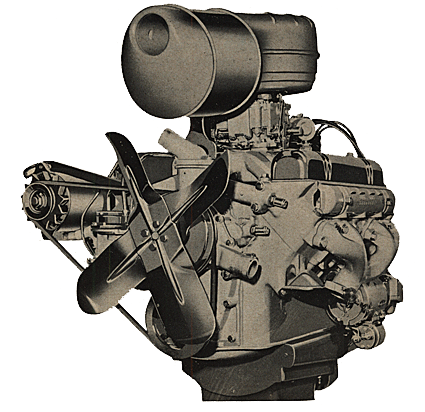
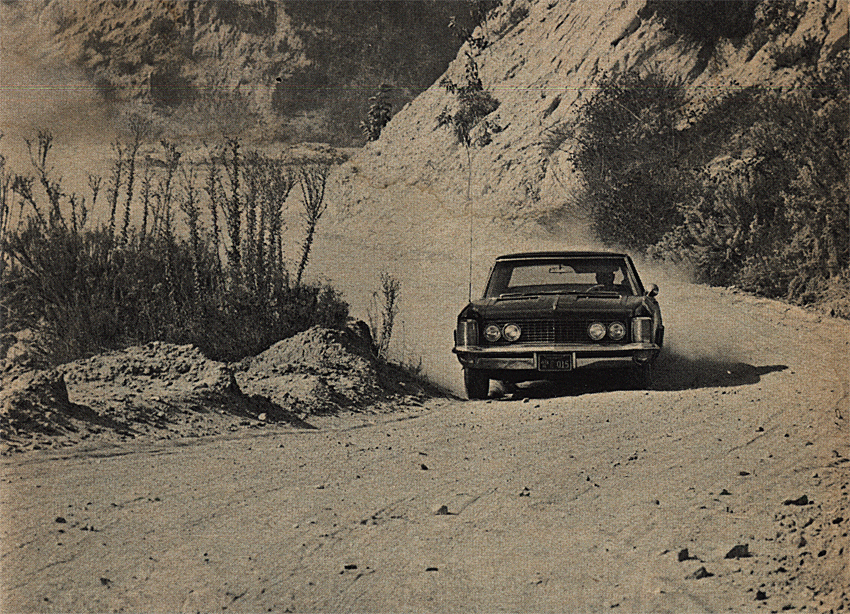 Smooth, silent behavior of stock Buick V8 is ideal for plush models like '63 Riviera.
Smooth, silent behavior of stock Buick V8 is ideal for plush models like '63 Riviera. been successful in NASCAR Grand National racing and, perhaps even more significant, it was the Buick engine that finally broke into the starting field at Indianapolis, where stock-block engines had virtually been overrun and shut out for years by the dominating Offenhauser and other all-out racing mills.
Buick engines are being used successfully today at the drag strip, in sports car racing and for engine swaps by more and more enthusiasts who have realized the high-performance potentiality and durability these power plants offer. In their stock form, coupled with the 26 models offered by Buick in 1963, they are both light and lively.
The current crop of Buick engines consists of three basic mills, ranging from the spectacular V6 to the small
but mighty aluminum V8 and the bigger 401 cubic-inch cast iron V8. All three, combined with good styling and other engineering features helped increase Buick production to 400,150 in 1962, the biggest year since 1956. An increase to 425,000 was anticipated for 1963, running the overall production figure to more than 11 million since the Buick was first built 60 years ago.
The Special V8 was introduced at the beginning of the 1961 model year as the basic engine for the Buick Special and promptly won national acclaim for its light weight and lively performance. It has a displacement of 215 cubic inches and weighs slightly more than 300 pounds, including carburetor, generator and starter, which makes it an excellent choice for swapping or hop-up. In its basic form, the aluminum V8 is capable of 155 hp at 4600 rpm.
Extensive planning and engineering went into the development of the Special V8. While aluminum was not exactly new to the industry, tooling and casting methods used here were the results of the latest techniques developed by GM engineers, to eliminate high costs and casting problems generally associated with aluminum.
Instead of using all steel dies for example, a permanent mold type system was employed using external steel molds but with internal passages made of sand cores. Molten aluminum is fed by gravity rather than by pressure so that no after bonding of the block and head sections is necessary. This system is a good deal cheaper than full die-casting and just as effective.
Specification-wise, the basic Special V8 has a bore and stroke of 3.50 x 2.80 inches, which gives the total 215 cubic inch displacement. Maximum torque is rated at 220 lb/ ft at 2400 rpm, and a single two-barrel carburetor is used. Compression ratio is 9-to-1.
An interesting comparison can be drawn between the Special V8, the 221-cubic-inch Ford Fairlane V8 and the 283 Chevy V8, showing the weight advantages of aluminum. The Buick is 200 pounds lighter than the Chevy and nearly 120 pounds lighter than the Fairlane, both of which are cast iron, of course.
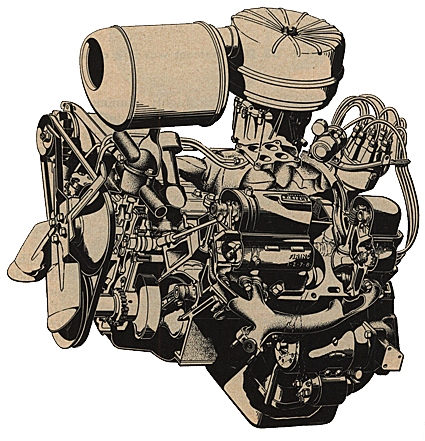
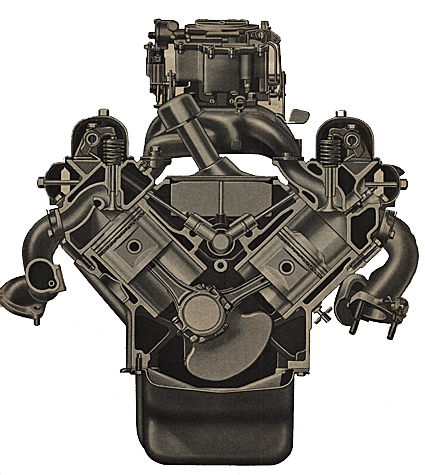
With all its accessories (starter, generator and carburetor) the Special weighs in at only 330 pounds (minus the flywheel and clutch assembly), and this can be appreciated further when you consider the fact that the bare block alone weighs but 57 pounds as compared to 144 pounds for the Chevy!
Ford engineers have done an excellent job on the Fairlane by utilizing new casting techniques to reduce weight of the cast iron block. They succeeded in coming up with a slightly smaller (in overall size) engine than the Buick, but there is still that matter of weight . . . more than a hundred pounds worth. The Buick still has the honor of being the lightest. As a matter of fact, the aluminum V8 weighs five pounds less than the Chevy II four-banger and is equal in weight to the Corvair flat six!
Further comparison shows that the basic Special V8 produces more horse-power with less weight and less displacement than the 221-cubic-inch Fairlane V8, and has only five less, horsepower than the 260 Fairlane V8. Little wonder then why more and more
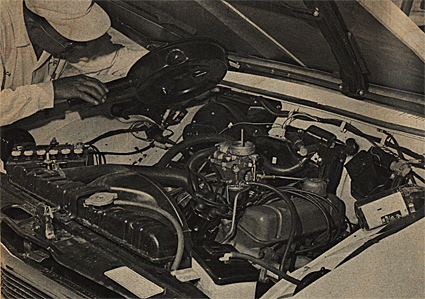
enthusiasts are going the Buick route. Just with basic modification work, it can be a real hauler.
Probably the best testimonial of the engine's durability was given during the 1962 500-mile race at Indianapolis where a highly modified version of the stock power plant was used in a rear-engine creation fielded by speed king Mickey Thompson. The car was driven by veteran Dan Gurney who out-qualified the majority of Offenhauser-powered cars in the race and was running well up in the pack when an oil seal came out of the rear end late in the race. The engine ran perfectly.
Halfway through the 1961 model year, Buick introduced a stepped-up version of the basic Special engine, a 185 hp bear (increased to 200 hp for '63) known as the Skylark. This increase in horsepower was achieved through four-barrel carburetion and a hotter cam, without changing bore, stroke or displacement. Compression ratio was raised, of course, from 9-to-1 to ll-to-l. This engine is standard on all Skylark models and is available as an optional engine for all other Buick Specials.
Worth noting here is the fact that the Skylark engine produces 40 more horses than the Fairlane 260 and five more horsepower than the big 283-cubic-inch Chevy, all on less weight and less -considerably less- displacement.
The Special V8 was replaced as the standard engine on the Buick Special in 1962, when Buick pulled the rug out from the rest of the industry by introducing its spectacular V6. Now standard equipment on the Special, the V6 has been heralded as the greatest engineering advance in modern automotive history. It is the only V6 passenger car engine produced in this country.
Introduction of the V6 in 1962 wasn't exactly a surprise. It had been known for more than a year previous that engineers were
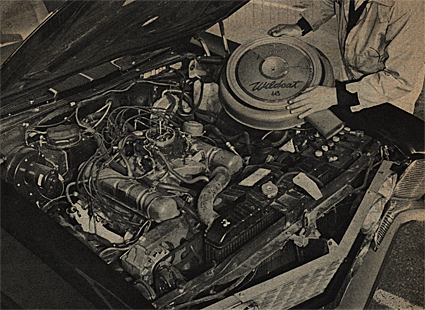
working on such a power plant, but few persons expected to see it in actual production so soon. In any case, there is no doubt that this revolutionary new power plant has been one of the most successful engineering developments to hit the industry in a good many years.
There are several reasons why GM brass decided upon a V6 rather than a standard in-line, ohv six. According to Buick's chief engineer, Lowell Kintigh, the decision was based upon common logic. Since Buick had produced only eight-cylinder engines for more than 30 years, there was a new market to be gained with the introduction of a six.
In the interest of production economics, a V6 design proved to be the best answer since it solved a number of problems. Competing six-cylinder engines were, for example, two cylinders longer than the Special's aluminum V8 power plant so there was a problem of fit in the existing engine compartment. Weight distribution also had to be considered as well as mounting points and interchangeability with the V8 transmission and other components already in production. Last but not least, V6 design was easily incorporated into assembly and tooling already set up for the V8.
The V6 solved those problems. It fit the existing engine compartment with plenty of room to spare, offered ideal weight distribution for the existing suspension system and, from a sales standpoint, offered the Buick dealer an exclusively new feature that really increased sales.
Basically, the V6 strongly resembles the aluminum V8, and most of the vital components are identical. It has a bore and stroke of 3.625 x 3.20 inches, with a total displacement of 198-cubic-inches. Horsepower is rated-at 135 at 4600 rpm with a maximum torque output of 205 lb/ft at 2400 rpm. Compression ratio is 8.8-to-1.
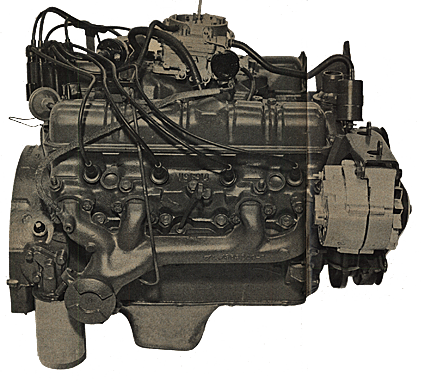
GM engineers did an outstanding job of overcoming balance problems which have been prominent with a V6 engine. Actually, they were problems of primary and secondary unbalance. The primary was handled in the same manner as for a 90-degree V8, by locating counter-weights on the crankshaft. The secondary unbalance, which is caused by parallel forces acting in opposite horizontal direction, was eliminated in the design of new motor mounts. Experience established that this was much easier to isolate in a 90-degree engine rather than a 60-degree or 120-degree V6.
The results have been pretty fantastic. Not only is the V6 smooth and quiet, it offers lively performance almost equal to the aluminum V8 and is quite economical. There is very little difference in fact, in low-end performance of the two engines. The difference can be noticed at the top end, where the V8 has the edge.
The V8 is not quite as economical as the V6 but here again, the two are quite close. The Special V8 is a two-time class winner in the Mobil gas Economy Run, producing as much as 25 mpg.
Overall, the V6 and its 90-degree configuration is considered efficient. In addition to smooth, lively performance, it is lighter and more compact than an in-line six and, thanks to all the research, designing and engineering that went into development of the aluminum V8, is being produced at low cost. Nearly all of the basic engineering was done with the development of the V8, and Buick was able to pass on the savings to the consumer.
Buick's basic big V8 is the 401-cubic-inch power plant that ranges in horsepower from 265 and 280 to 325. Power teams are available for application to the LeSabre, Invicta, Wildcat, Electra and Riviera, with a choice of two-or four-barrel carburetion and a range in compression ratio from 9-to-1 to 10.25-to-1.
The 401 has a bore and stroke of 4.1875 x 3.64 inches and, until the middle of the 1963 model year, rated as Buick's biggest engine. For 1963 1/2 however, Buick introduced its current 425-cubic-inch version which is capable of 340 horsepower at 4400 rpm, with a torque output of 465 lb/ft at 2800 rpm.
Chief differences here over the 401 is an increase in bore size. The 425 has been punched out to 4.315 inches to account for the increase in displacement, but retains the same 3.64-inch stroke. There is a difference in cams and valve timing, and a four-barrel Carter carburetor is standard while hydraulic lifters and all other components are the same as the 401.
The LeSabre, Buick's smallest big car, employs the 401 with two-barrel carburetor, 10.25-to-1 compression and 280 hp as its standard engine. Two optional versions are available including the 265 hp engine with two-barrel carburetion and 9-to-1 compression, and the 325 hp power plant with a single four-barrel and 10.25-to-1 compression.
The latter, 325 hp engine is also standard on the Invicta, Wildcat, Electra and Riviera.